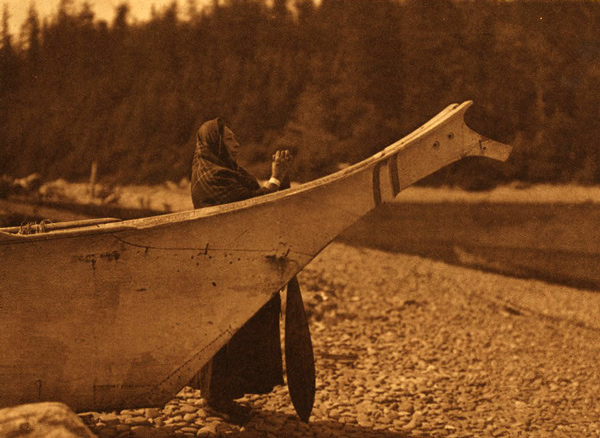Fort Clatsop, Astoria, OR Drouillard is sent to buy two new canoes from the Clatsops, and several men are out hunting, retrieving elk meat, or looking for a lost dugout canoe. Lewis discusses coastal fish species.
Watching for Salmon – Quinault
Edward S. Curtis (1868–1952)
Northwestern University Library, Edward S. Curtis’s “The North American Indian,” 2003.[1]Edward S. Curtis, The North American Indian (1907-1930) v.9, The Salishan Tribes of the Coast. The Chimakum and the Quilliute. The Willapa. ([Cambridge: The University Press], 1909), plate facing … Continue reading
Porpoises in the River[2]Originally aired weekdays by Yellowstone Public Radio during the Bicentennial observance of 2003-2006. Narrated by Hal Hansen. Scripts by Whit Hansen and Ed Jacobson. Produced by Leni Holliman. © … Continue reading
Looking for Canoes
our three hunters returned to the fort. had killed two Elk and two deer. Drewyer Sent to the Clatsop village in order to purchase a canoe. I went with Six more of the party after the meat of an Elk. Sergt. Pryor and 2 men went to look again for the lost canoe. in the evening all returned to the fort. Collins who went with Sergt. Pryor had killed two doe Elk and wounded 1 or 2 more
—John Ordway
Chinook Salmon and Trout
the common Salmon and red Charr are the inhabitants of both the sea and rivers. the former is usually largest and weighs from 5 to 15 lbs. it is this speceis that extends itself into all the rivers and little creeks on this side of the Continent, and to which the natives are so much indebted for their subsistence.
—Meriwether Lewis
Starry Flounder
The flounder is also an inhabitant of the salt water, we have seen them also on the beach where they had been left by the tide. the Indians eat [them] and esteem it very fine.
—Meriwether Lewis
Celestial Observations
Observed Equal Altitudes of the
with Sextant . . . . chronometer too slow on Mean Time—
—Meriwether Lewis
Weather Diary
Aspect of the weather at Rise
Wind at rise
Aspect of weather at 4 O’Ck P. M. Wind at 4 OCk. P. M. fair after rain N E. fair N E slight frost this morning. a little rain fell in the latter part of the night. saw a number of insects in motion; among others saw for the fist time this spring and winter a downey black fly about the size of the common house fly. the plants begin to appear above the ground, among others the rush of which the natives eat the root. and the plant, the root of which resembles in flavor the sweet potato also eaten by the natives.
—Meriwether Lewis[3]To assist the reader, the editor of this web page has omitted the “Day of the Month” column and spelled out some abbreviations.
Fort Clatsop is a High Potential Historic Site along the Lewis and Clark National Historic Trail managed by the U.S. National Park Service. The site is managed by the Lewis and Clark National and State Historic Parks.
Notes
| ↑1 | Edward S. Curtis, The North American Indian (1907-1930) v.9, The Salishan Tribes of the Coast. The Chimakum and the Quilliute. The Willapa. ([Cambridge: The University Press], 1909), plate facing page 130. |
|---|---|
| ↑2 | Originally aired weekdays by Yellowstone Public Radio during the Bicentennial observance of 2003-2006. Narrated by Hal Hansen. Scripts by Whit Hansen and Ed Jacobson. Produced by Leni Holliman. © 2003 by Yellowstone Public Radio. |
| ↑3 | To assist the reader, the editor of this web page has omitted the “Day of the Month” column and spelled out some abbreviations. |



